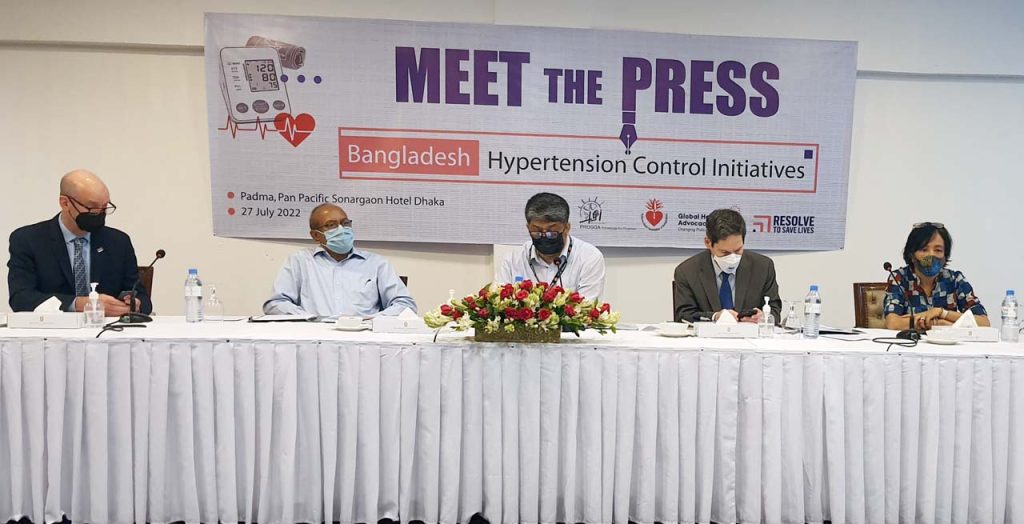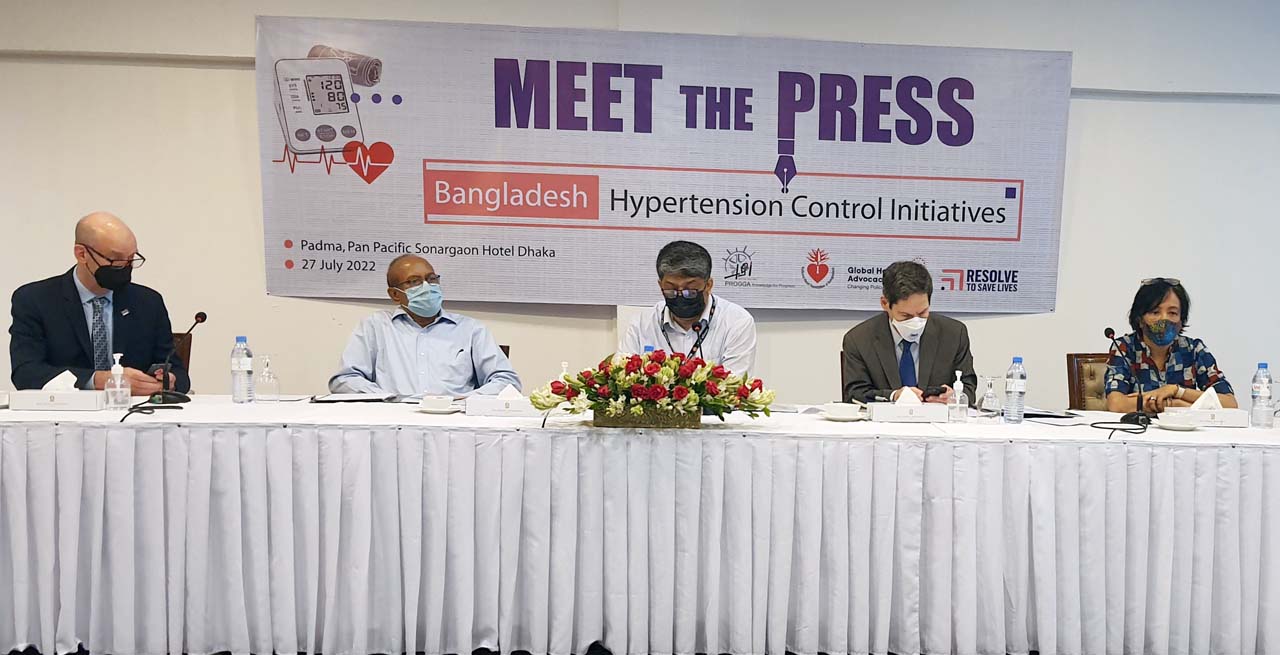

Life-saving care for high blood pressure, also known as hypertension—the leading preventable risk factor for heart disease, heart attacks, and strokes—could be expanded nationwide in Bangladesh for about US$9 per patient per year, according to a new study published in the British Medical Journal. The study findings were shared today (27 July 2022, Wednesday) during a Meet the Press event titled “Bangladesh Hypertension Control Initiatives” held at the Pan Pacific Sonargaon Hotel in the capital. The event was jointly organized by the NCDC Program of the Directorate General of Health Services (DGHS), PROGGA (Knowledge for Progress), the National Heart Foundation of Bangladesh (NHFB), and Global Health Advocacy Incubator (GHAI), and Resolve to Save Lives.
Since 2018, the Non-Communicable Disease Control Program (NCDC), Directorate General of Health Services (NCDC DGHS) of the Ministry of Health & Family Welfare and the National Heart Foundation of Bangladesh (NHFB) have collaborated with Resolve to Save Lives, a global health non-profit organization, to implement a program strengthening the detection, treatment and follow-up of high blood pressure in primary care. Expansion of the highly successful initial project would save lives in Bangladesh by preventing heart attacks, strokes, kidney failure and expensive hospitalizations for these conditions, and at an affordable cost.
“In Bangladesh, one out of every five adults has hypertension,” said Dr. Tom Frieden, President and CEO of Resolve to Save Lives and former Director of the U.S. Centers for Disease Control and Prevention. “Many lives can be saved—and heart attacks and strokes prevented—by investing in strengthening primary care services to provide blood pressure treatment to Bangladeshi adults.”
Although most people’s high blood pressure can be controlled with a simple medication regimen, of the estimated 22 million people with high blood pressure in Bangladesh, it is estimated that only 49% have been diagnosed, 35% are receiving treatment, and 14% have their blood pressure under control.
The hypertension control program from NCDC DGHS and NHFB has been successfully implemented in 51upazila health complexes, which offer hypertension care that aligns with the World Health Organizations’ HEARTS technical package. The program has so far registered 100,000 patients for treatment and has controlled blood pressure in 58% of patients in treatment.
“Thirty percent of deaths in Bangladesh are from heart disease, but less than 5% of Bangladesh’s health sector budget is allocated to addressing non-communicable diseases,” said National Professor Brig (Rtd.) Abdul Malik, Founder and President of the National Heart Foundation of Bangladesh. “There is an urgent need to improve control of high blood pressure, which the pilot program shows can be done at low cost through primary health care, even at the national level.”
The study, which used the HEARTS costing tool, an application designed to estimate annual hypertension control program costs, suggests that the HEARTS package would be even more affordable if there is more task-sharing among medical doctors and non-physicians and increased task sharing among allied health workers such as Community Health Care Providers, and further reduced by decreasing the unit cost of quality assured medications. Expanding the roles of nurses and other health care providers to support blood pressure management could save money and make providing treatment more feasible nationally and more accessible to patients. The study was conducted with funding from Bloomberg Philanthropies.
“The hypertension control program piloted by NCDC DGHS, and the National Heart Foundation, in collaboration with Resolve to Save Lives, is succeeding by incorporating the principles of task-sharing and team-based care,” said Professor Md Robed Amin, Line Director, Non-Communicable Disease Control Program, Directorate General of Health Services. “In the span of two years, the program has registered more than 100,000 patients—averaging more than 4,000 new patients a month—with a 58% blood pressure control rate, almost fourfold the national average.”
The hypertension control program uses global best practices, including simple treatment protocols with specific medications, dosages and action steps for hypertension treatment to streamline care and improve adherence; team-based care and task-sharing; regular, uninterrupted access to affordable and good quality medications; patient-centered care, such as easy-to-take medication regimens, free medications and follow-up visits; and effective health information technology to help determine how hypertension patients are doing and catalyze rapid improvements in the quality of care.
The burden of hypertension in Bangladesh is expected to grow in the coming years due to an aging population, rapid urbanization, increases in sedentary lifestyles, processed food consumption, and other socioeconomic and lifestyle factors. Expansion of the Bangladesh Hypertension Control Initiative could save many lives, and at a cost, the country can afford.

